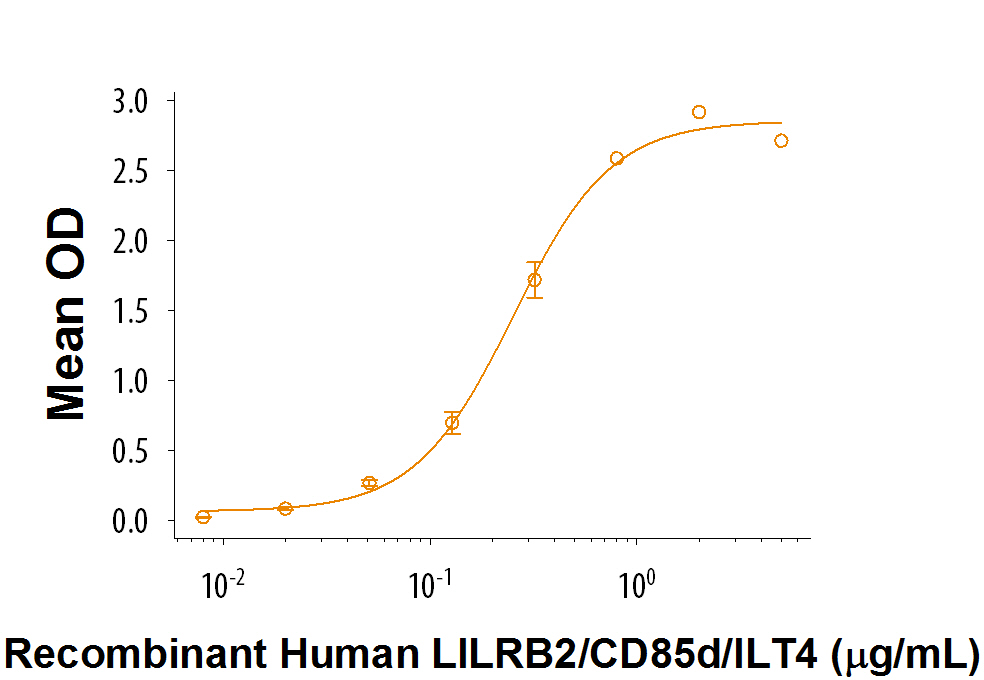Recombinant Mouse Angiopoietin-like Protein 4/ANGPTL4, CF
Recombinant Mouse Angiopoietin-like Protein 4/ANGPTL4, CF Summary
Product Specifications
Leu169-Ser410, with a C-terminal 6-His tag
Analysis
Product Datasheets
Carrier Free
CF stands for Carrier Free (CF). We typically add Bovine Serum Albumin (BSA) as a carrier protein to our recombinant proteins. Adding a carrier protein enhances protein stability, increases shelf-life, and allows the recombinant protein to be stored at a more dilute concentration. The carrier free version does not contain BSA.
In general, we advise purchasing the recombinant protein with BSA for use in cell or tissue culture, or as an ELISA standard. In contrast, the carrier free protein is recommended for applications, in which the presence of BSA could interfere.
9797-AN
| Formulation | Lyophilized from a 0.2 μm filtered solution in PBS. |
| Reconstitution | Reconstitute at 500 μg/mL in PBS. |
| Shipping | The product is shipped at ambient temperature. Upon receipt, store it immediately at the temperature recommended below. |
| Stability & Storage: | Use a manual defrost freezer and avoid repeated freeze-thaw cycles.
|
Scientific Data
 View Larger
View Larger
When Recombinant Mouse Angiopoietin-like Protein 4/ANGPTL4 (Catalog# 9797-AN) is immobilized at 1 µg/mL, 100 µL/well, Recombinant Human LILRB2/CD85d/ILT4 Fc Chimera (Catalog # 2078-T4) binds with an ED50 of 0.09-0.54 µg/mL.
Reconstitution Calculator
Background: Angiopoietin-like Protein 4/ANGPTL4
Angiopoietin-like 4 (ANGPTL4), also known as FIAF, FARP, and PGAR, is a 55 kDa glycoprotein secreted by the liver and fat tissue. It is structurally related to the angoipoietins and contains an N-terminal coiled coil domain and a C-terminal fibrinogen-like domain which can be proteolytically separated in vivo (1). Amino acid 169‑410 contains the C-terminal fibrinogen like domain within mouse ANGPTL4, and this domain shares 75% and 97% sequence identity with human and rat homologs, respectively. The coiled coil domain, which is not glycosylated, mediates the formation of variable sized disulfide-linked oligomers (2). This domain directly inhibits lipoprotein lipase, resulting in increased circulating triglyceride levels (3, 4). In humans, the N-terminal fragment and full length ANGPTL4 physically associate with HDL (4). In mouse, however, full length ANGPTL4 associates with HDL, while the N-terminal fragment associates with LDL (4). Circulating ANGPTL4 is decreased in type II diabetics with a subsequent loss of its normal plasma glucose lowering activity (5). Its expression in adipose tissue is induced by fasting and suppressed by feeding (6). In hypoxic areas, ANGPTL4 is induced in both vascular endothelial cells and tumor cells (7, 8). The N-terminal fragment can function as an angiogenesis inhibitor (7, 8). In contrast, the C-terminal fragment modulates cell adhesion through interactions with heparan sulfate proteoglycans, Integrins beta 1 and beta 5, Vitronectin, and Fibronectin, thereby promoting keratinocyte migration and wound healing (7, 9, 10). ANGPTL4 additionally enhances the survival of hematopoietic and mesenchymal stem cells (11, 12). The expression of an undersialylated form of ANGPTL4 in renal podocytes contributes to proteinuria and nephrotic syndrome (13). The immune-inhibitory receptor human leukocyte immunoglobulin-like receptor B2 (LILRB2) and its mouse orthologue paired immunoglobulin-like receptor (PIRB) have been identified as receptors for several ANGPTLs (14) including ANGPTL4.
- Zhu, P. et al. (2012) Biosci. Rep. 32:211.
- Ge, H. et al. (2004) J. Biol. Chem. 279:2038.
- Sukonina, V. et al. (2006) Proc. Natl. Acad. Sci. USA 103:17450.
- Mandard, S. et al. (2006) J. Biol. Chem. 281:934.
- Xu, A. et al. (2005) Proc. Natl. Acad. Sci. USA 102:6086.
- Kersten, S. et al. (2000) J. Biol. Chem. 275:28488.
- Cazes, A. et al. (2006) Circ. Res. 99:1207.
- Le Jan, S. et al. (2003) Am. J. Pathol. 162:1521.
- Goh, Y.Y. et al. (2010) Am. J. Pathol. 177:2791.
- Goh, Y.Y. et al. (2010) J. Biol. Chem. 285:32999.
- Blank, U. et al. (2012) Eur. J. Haematol. 89:198.
- Hou, M. et al. (2014) PLoS ONE 9:e85808.
- Clement, L.C. et al. (2011) Nat. Med. 17:117.
- Zhang, C.C. et al. (2012) Nature 485:656.
FAQs
No product specific FAQs exist for this product, however you may
View all Proteins and Enzyme FAQsReviews for Recombinant Mouse Angiopoietin-like Protein 4/ANGPTL4, CF
There are currently no reviews for this product. Be the first to review Recombinant Mouse Angiopoietin-like Protein 4/ANGPTL4, CF and earn rewards!
Have you used Recombinant Mouse Angiopoietin-like Protein 4/ANGPTL4, CF?
Submit a review and receive an Amazon gift card.
$25/€18/£15/$25CAN/¥75 Yuan/¥1250 Yen for a review with an image
$10/€7/£6/$10 CAD/¥70 Yuan/¥1110 Yen for a review without an image
